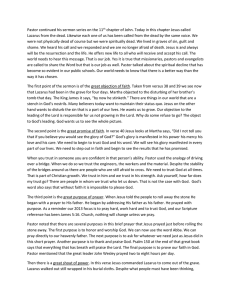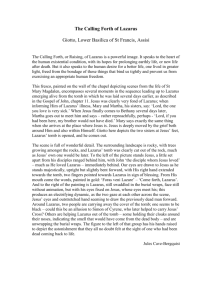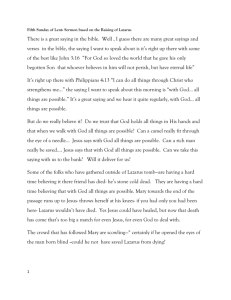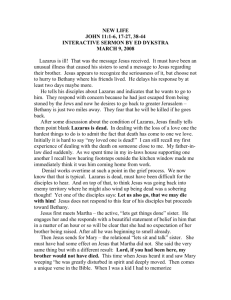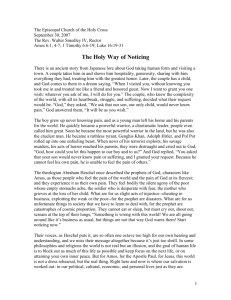Life Among The Graves John 11:32-44
advertisement
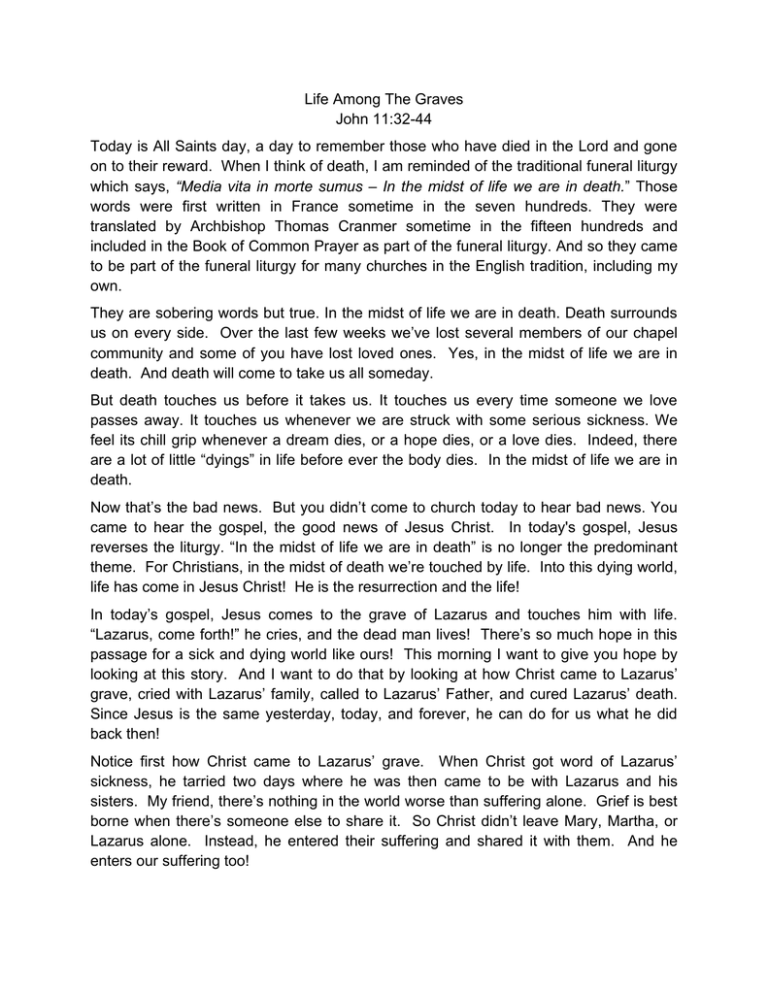
Life Among The Graves John 11:32-44 Today is All Saints day, a day to remember those who have died in the Lord and gone on to their reward. When I think of death, I am reminded of the traditional funeral liturgy which says, “Media vita in morte sumus – In the midst of life we are in death.” Those words were first written in France sometime in the seven hundreds. They were translated by Archbishop Thomas Cranmer sometime in the fifteen hundreds and included in the Book of Common Prayer as part of the funeral liturgy. And so they came to be part of the funeral liturgy for many churches in the English tradition, including my own. They are sobering words but true. In the midst of life we are in death. Death surrounds us on every side. Over the last few weeks we’ve lost several members of our chapel community and some of you have lost loved ones. Yes, in the midst of life we are in death. And death will come to take us all someday. But death touches us before it takes us. It touches us every time someone we love passes away. It touches us whenever we are struck with some serious sickness. We feel its chill grip whenever a dream dies, or a hope dies, or a love dies. Indeed, there are a lot of little “dyings” in life before ever the body dies. In the midst of life we are in death. Now that’s the bad news. But you didn’t come to church today to hear bad news. You came to hear the gospel, the good news of Jesus Christ. In today's gospel, Jesus reverses the liturgy. “In the midst of life we are in death” is no longer the predominant theme. For Christians, in the midst of death we’re touched by life. Into this dying world, life has come in Jesus Christ! He is the resurrection and the life! In today’s gospel, Jesus comes to the grave of Lazarus and touches him with life. “Lazarus, come forth!” he cries, and the dead man lives! There’s so much hope in this passage for a sick and dying world like ours! This morning I want to give you hope by looking at this story. And I want to do that by looking at how Christ came to Lazarus’ grave, cried with Lazarus’ family, called to Lazarus’ Father, and cured Lazarus’ death. Since Jesus is the same yesterday, today, and forever, he can do for us what he did back then! Notice first how Christ came to Lazarus’ grave. When Christ got word of Lazarus’ sickness, he tarried two days where he was then came to be with Lazarus and his sisters. My friend, there’s nothing in the world worse than suffering alone. Grief is best borne when there’s someone else to share it. So Christ didn’t leave Mary, Martha, or Lazarus alone. Instead, he entered their suffering and shared it with them. And he enters our suffering too! Over the course of my ministry I’ve spoken with many people who have lost their faith because of some suffering. I spoke with a young man not long ago. He told me a truly tragic tale. It broke my heart. And then at the end he said something like this: “Chaplain, why did God let it happen and where was God when it did?” I said, “Son, when God made us he gave us freedom. And in our freedom we sometimes make choices that bring harm to ourselves and to others. You’ve been hurt by the bad choices of those around you. So what does God do with a world like this? Well he doesn’t take our freedom from us; rather, he shares its consequences with us. So what’s the answer to your question? It’s the Cross! God came in Christ to share our suffering. God comes in Christ to share it still. We are not alone!” My friend, the scripture says Jesus is the same yesterday, today, and forever. (Heb. 13:8) Just as Jesus came to Mary, Martha, and Lazarus, he comes to us to share our sorrows too. Rest assured he’s with you whenever you feel like you are dying. Rest assured, he’s with you when death comes knocking at your door. You are not alone! As the old song says, In ev’ry pang that rends the heart, The Man of Sorrows had a part! He sympathizes with our grief, And to the sufferer sends relief.i And that relief is Christ himself! He comes to us with comfort in his hands! There’s tremendous hope in that thought. Christ came to Lazarus’ grave. Christ comes to you too! You are not alone! Christ not only came to Lazarus’ grave but he cried with Lazarus’ family. When Jesus saw the tears of Mary and the crowd, he began to weep as well. And every tear testified to the fact that Jesus cared! “See how he loved him!” the crowd said when they saw him weeping. And they were right! Jesus cared for Lazarus! Jesus cared for Mary! Jesus cared for Martha! And Jesus cares for you! His tears testify to the truth of it! The Reverend Dr. Thomas Butts tells of a little girl who stayed out at play much longer than she was supposed to stay. When she got home, her mother fussed at her for being out so long and asked her where she had been. The little girl said one of her friends had broken a doll and she had stopped for two hours to help her fix it. Her mother asked her how she could spend two hours fixing a broken doll. The little girl looked up at her and said, “I couldn’t fix the doll so I sat down and helped her cry.”ii You see, that little girl cared enough to cry with her friend. Like that little girl, Jesus cares enough to cry with us in our sufferings. There may be no tears in heaven but we’re not in heaven yet. And the Bible says Jesus sympathizes with us in our weakness! (Heb. 4:15) So rest assured, as he cried for Lazarus’ family, he sympathizes with you when you feel like you’re dying; he sympathizes with you when death comes knocking at your door. As the old song says, Our fellow sufferer yet retains A fellow feeling of our pains: And still remembers in the skies His tears, His agonies, and cries.iii Yes, he still remembers in the skies – his tears, his agonies, and his cries! There’s hope and comfort in that thought. Jesus cried for Lazarus. Jesus cares for you! My friend, Christ not only came to Lazarus’ grave and cried with Lazarus family but he called to Lazarus’ Father. As Jesus stood before the tomb, he ordered the grave opened then lifted his eyes to heaven and prayed: “"Father, I thank you for having heard me." (Jn. 11:41) You see, Jesus prayed for Lazarus to be raised. When did he pray? We’re not sure. Perhaps he prayed when he first heard of Lazarus’ sickness and subsequent death. But my point is this: Jesus called to Lazarus’ father. He prayed for Lazarus’ life. Now in a time of crisis, all of us want prayer, so we enlist family members, friends, and fellow believers to pray for us according to our need. For that reason, we have a prayer team here at the chapel and they receive numerous requests every week from desperate people enlisting others to pray for them and those they love. Perhaps you’ve called on them and asked them to pray for you. Well did you know that in the mystery of the Trinity, Jesus is praying for you too! The Son of God is pleading your case before his Father’s throne. Romans 8:35 says, “Christ Jesus died for us and was raised to life for us, and he is sitting in the place of honor at God's right hand, pleading for us.” (NLT) Think of it! Jesus is praying for you! He’s calling to his Father on your behalf! He’s petitioning your case before his Father’s throne! He’s pleading for your wellbeing! Now James 5:16 says, “The prayer of the righteous is powerful and effective.” (NRSV) James proves the point by citing an incident from the life of the prophet Elijah. James says, “Elijah was a human being like us, and he prayed fervently that it might not rain, and…it did not rain.” (Ja. 5:17 NRSV) If the prayers of a righteous prophet were that powerful, how much more powerful are those of the sinless Son of God! Powerful enough to raise the dead according to our text! So who knows what might happen in response to the prayers of Jesus! There’s always hope so long as he is praying on our behalf! Finally, we see that Jesus not only came to Lazarus’ grave, cried with Lazarus’ family, and called to Lazarus Father, but he cured Lazarus death! After calling to the Father, Jesus called to Lazarus and said, “Lazarus, come out!” And the dead man lived! Now listen, great mystery surrounds human suffering and God’s healing. We know God heals some and not others. He heals in his time and not ours. He works in his way and not our ways to accomplish his will. And there are no easy explanations of why he heals one and not another, why he heals then and not now, why he cures in this way and not that. But even though there are no easy explanations to all our natural questions, there is abundant evidence that Christ cures – in his way, in his time, for his glory and our good. You see, he raised Lazarus for his own glory. When he first heard of Lazarus’ sickness Jesus said, “This illness does not lead to death; rather it is for God’s glory, so that the Son of God may be glorified through it.” (Jn. 11:4 NRSV) Then he waited two days before going to Bethany to raise a dead Lazarus. You see, it was for his glory, in his way, and his time. And he did get glory by if for many came to faith as a consequence of this sign. (See Jn. 11:45) Yes, he raised Lazarus for his glory. And he also raised Lazarus for the good of Lazarus and his grieving family. Can you imagine how happy they were when Jesus raised Lazarus from the dead? That’s the way Jesus works – always for his glory and always for our good. So this story reminds us that Christ is doing something for us even when we cannot see it. He was at work despite the sickness. He was at work despite the delay. He was at work despite the dying. And he was at work in the rising. Yes, he’s always doing something for his glory and our good, in his way and his time. It’s just the way he works. If you truly believe that then you can always live with a pregnant hope. There may be pain in the process of delivery, but God’s glory and your good will be born for you some day! If not on earth then in heaven! My friend, Jesus said to Martha, “I am the resurrection and the life. Those who believe in me, even though they die, will live, and everyone who lives and believes in me will never die. Do you believe this?” (Jn. 11:25-26 NRSV) Brenda Schoener believes it. Phil Burgess, one of our members, writes about her in his weekly newspaper column. Brenda is 75. She’s a pastor’s wife in Severna Park. Throughout her long life she’s served Christ in countless ways and made the world a better place; but now she’s dying with thyroid cancer and doesn’t have very long to live. In her interview with Phil she said, "I am blessed in so many ways. I have my husband, my friends and neighbors and my church so I can say my good-byes and my gratitudes. If you stop and think about it, it's a real blessing to know in advance when your time is up.” Then she added this: "I've had 75 perfect years. Hospice keeps me pain and worry free so I can enjoy my friends and family members as they come and go. I am not afraid. I am joy-filled. I will not struggle. I will be at peace."iv In the midst of death Brenda has been touched by life – the life giving hand of Jesus Christ! You can be too, if only you’ll believe in him and entrust your life unto him! Jesus said, “I am the resurrection and the life…Do you believe this?” My friend, do you believe it? As he did for Lazarus, do you believe that Jesus comes to you, cares for you, calls to the Father on your behalf and can cure you for his glory and your good, in his way and in his time? If so, then you know that death no longer has its way. In the midst of death you’ve been touched by life – life abundant in the present and life eternal beyond the grave! And that, my friend, is good news and a great hope! Do you believe it? Will you believe it? Will you believe it today? Here’s praying that you will. Amen! i “Where High The Heavenly Temple Stands” by Michael Bruce, circa 1764. “Weeping With One Eye” by the Rev. Dr. Thomas Lane Butts. Found at http://day1.org/908weeping_with_one_eye. iii Ibid, Bruce. iv “Even an unexpected journey cannot detour a purpose driven life” by Phil Burgess. Found at http://www.booternation.com/booter-blog/even-unexpected-journey-cannot-detour-purpose-driven-life. ii

